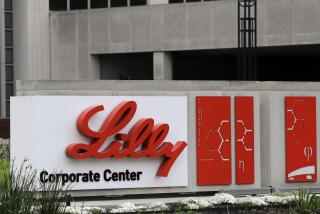A Parent Scrambles to Keep Hope Alive
- Share via
Pat Harris cried for three days in April when she got the letter from UCLA Children’s Hospital.
A drug that had transformed her daughter’s life would no longer be available in the U.S. as of September.
Harris, a San Marino mother of two, had four months to find a solution.
“There was just no way my daughter was going off that drug,” she said.
Not after what Harris had lived through for five years in the 1980s, watching her daughter suffer 40 to 50 seizures a day.
Amy Harris, now 18, has Lennox-Gastaut syndrome, a rare and distressing form of childhood epilepsy. As a little girl, she experienced endless “drop” attacks that sent her crashing to the ground without warning like a marionette with its strings cut. She dislocated her shoulders so often that her mother became adept at shoving the bone back into place.
The disorder usually leads to gradual mental deterioration and retardation. In addition, 80% who are afflicted continue to have seizures throughout their lives.
Amy has an IQ of 40 and functions at the level of a 2-year-old. When she was 5, her mother enrolled her in an experimental study for a drug called nitrazepam, which had previously been used overseas for treatment of sleep disorders.
The girl’s seizures stopped immediately. She has been seizure-free ever since.
During the past few months, Amy’s doctor at UCLA agreed to take the steps necessary to acquire nitrazepam from an overseas pharmacy. But that did not forestall the fears of the Harris family that Amy will no longer be able to count on a stable supply.
Galvanized by that fear, Harris has single-handedly tracked down and mobilized dozens of nitrazepam-dependent families throughout the country, creating an emotional campaign to guarantee the drug’s availability.
“She was the one who focused everyone in a direction,” said Peggy Marsh, a Cincinnati woman whose son, Brian, has taken nitrazepam for the last 17 years.
The makers of nitrazepam, Swiss-based pharmaceutical giant Hoffman-La Roche, decided in the early 1980s to quit seeking Food and Drug Administration approval to sell the compound in this country.
A U.S. spokeswoman for the company refused in a recent interview to explain the decision beyond saying that the FDA thought that the information the company had submitted was not adequate.
Instead, Hoffman-La Roche decided to send free shipments of nitrazepam from its overseas labs to the small community of needy patients that was soon to include Amy Harris.
As many as 500 UCLA outpatients were taking the drug at one point, but that number has since been pared to 25 as new epilepsy drugs have come on the market. Amy’s physician, Dr. Donald Shields, said Amy’s seizures were controllable only by nitrazepam.
How many patients still need the drug is a matter of dispute. The drug company says it believes there are only a handful in the nation. Harris says she has been able to document more than 120 through contact with a small fraction of nitrazepam-prescribing doctors in the U.S. She estimates that there are about 500 nitrazepam-dependent patients in all.
Earlier this year, Hoffman-La Roche, which does $12 billion in annual sales, made another business decision: It would no longer assume responsibility for importing the drug from overseas and distributing it to U.S. patients.
Harris’ three days of tears began. She wrote to protest.
“Periodically we reassess our product line and how we are spending our resources,” a Hoffman-La Roche spokeswoman wrote back. “In the case of nitrazepam, a significant amount of staff time was being spent in coordinating the importation of the drug from overseas.”
The calculus was simple, a Hoffman-La Roche executive wrote Harris in another letter:
“The resources that become available to us following closure of this program will allow us to better focus on developing new medicines for patients with major illnesses.”
The company told Harris a straightforward solution existed: Doctors could import the drugs themselves. They would simply have to file for a special Drug Enforcement Administration license to import nitrazepam as a Class IV controlled substance.
“It’s fairly simple paperwork,” said company spokeswoman Kelli McLaughlin.
Doctors and families shake their head in bewilderment at that claim.
Jumping Through Hoops
They note that doctors must contact their local DEA office for the required forms, file for the license, which is renewable yearly, pay $70, wait several weeks for approval, locate a foreign pharmacy where the drug is sold, send a copy of the prescription request to the pharmacy, and file a “Controlled Substances Import/Export Declaration” with the DEA 15 days before anticipated import. If the DEA has any objections, it will contact the doctor within 15 days. After the 15 days have elapsed, the request is forwarded to the foreign pharmacy. Payment can be made with a credit card, but if the doctor wishes to get reimbursed by the patient for the drug, he or she must request approval for charging from the FDA by submitting a full written explanation.
Finally, a 90-day supply is sent.
If the doctor, anticipating potential problems, doesn’t want to run out before the end of the three-month period, the process becomes almost continuous.
This is on top of the regular status reports doctors prescribing the drug already send the FDA.
“It’s going to be very, very hard for a doctor who is not at a university-affiliated hospital,” said Abby Meyers, president of the National Organization for Rare Disorders, a nonprofit group that often comes to the aid of patients like Amy Harris.
Harris’ doctor, Shields, and his university are willing to do the work. But she and other parents are fearful because their lives are now inextricably wedded to a single doctor.
In Cincinnati, Peggy Marsh found out that not only was the drug no longer going to be available, but her neurologist was retiring as well.
“I panicked,” said Marsh. “I was facing starting from scratch with a new neurologist.”
Fortunately, Marsh’s new neurologist agreed to begin the process of seeking a license from the FDA and DEA. But Marsh remains uneasy. “My life now depends on whether this doctor decides to stay in Cincinnati and practice.”
Another concern is the financial burden. Because the drug is not FDA-approved, it is not covered under insurance. At $40 for a bottle of 100, the cost adds up quickly for patients, some of whom take 10 pills a day.
It was against this backdrop that Pat Harris, a former YMCA director who has a college degree in community organization, took out her Christmas list and asked all her friends to write letters to Hoffman-La Roche to reconsider.
She moved on to members of Congress. She wrote to President Clinton and received a call from the White House, which put her in touch with the FDA’s Office of Orphan Products Development.
The Orphan Drug Act was passed by Congress in 1983, offering financial incentives for companies to develop drugs for rare disorders. The law targets diseases that affect as few as several hundred people. The FDA has approved 170 orphan drugs and has designated about 850 others pending further experimentation.
Nitrazepam seemed like a natural. But Harris and others were blocked because Hoffman-La Roche has steadfastly refused to consider seeking orphan-drug status for the medication, since it would mean additional clinical tests.
Harris continued spending hundreds of dollars on photocopies, stamps, and long-distance phone calls, sometimes devoting up to 40 hours a week. She sent three separate mailings to all of the 54 nitrazepam-prescribing doctors in the United States, 10 of whom sent her letters on to their patients. She sent three more mailings to nitrazepam families, imploring them to join her fight. An Omaha, Neb., family with a teenager who has been on nitrazepam for 11 years has joined her in filing a federal discrimination lawsuit against the company.
Harris has made some small dents.
The Epilepsy Foundation, a national advocacy organization for patients with the condition, recently decided to throw its weight behind Amy Harris and other nitrazepam users, issuing a strongly worded rebuke of Hoffman-La Roche and making plans to meet with the company.
The Epilepsy Society of America agreed to hold a special meeting on nitrazepam at its annual conference in San Diego in December.
Harris hopes a group of researchers will consider applying for a grant and put together a study that would lead to the drug’s approval as an orphan drug, independent of its manufacturer.
However, her mission was further complicated when Hoffman-LaRoche last month sold the rights to nitrazepam to a Costa Mesa-based company, ICN Pharmaceuticals Inc. A spokesman for ICN indicated last week that the company probably will not try to market the drug in the U.S., but said the firm is aware of the plight of families like Harris’ and will try to accommodate them.
Meanwhile, on a recent afternoon, Amy Harris, an outgoing but awkward teenager, showed surprising skill on the basketball court, to the delight of her mother, who explained that the girl’s motor skills have been left largely intact.
Amy crouched over and concentrated intently as she dribbled down the court. She reared back and let fly a shot, only to have it clang off the backboard.
Several attempts later, she finally banked one in, raising her arms in triumph, a testament to what her mother had said a couple minutes before:
“You have to be tenacious and hang in there and fight like heck.”
More to Read
Sign up for Essential California
The most important California stories and recommendations in your inbox every morning.
You may occasionally receive promotional content from the Los Angeles Times.












